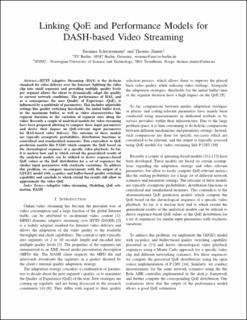| dc.contributor.author | Schwarzmann, Susanna | |
| dc.contributor.author | Zinner, Thomas | |
| dc.date.accessioned | 2021-02-26T06:55:12Z | |
| dc.date.available | 2021-02-26T06:55:12Z | |
| dc.date.created | 2020-12-06T14:11:07Z | |
| dc.date.issued | 2020 | |
| dc.identifier.isbn | 978-1-7281-5684-2 | |
| dc.identifier.uri | https://hdl.handle.net/11250/2730519 | |
| dc.description.abstract | HTTP Adaptive Streaming (HAS) is the de-facto standard for video delivery over the Internet. Splitting the video clip into small segments and providing multiple quality levels per segment allows the client to dynamically adapt the quality to current network conditions. The performance of HAS, and as a consequence the user Quality of Experience (QoE), is influenced by a multitude of parameters. This includes adjustable settings like quality switching thresholds, the initial buffer level, or the maximum buffer, as well as video characteristics like segment duration or the variation of segment sizes along the video. Recently, a couple of analytical models for video streaming have been proposed, allowing to compare these input parameters and derive their impact on QoE-relevant metrics for HAS-based video delivery. The outcome of these models are typically asymptotic probabilities, distribution functions, or centralized and standardized moments. For instance, these models do not yield any temporal information in terms of stalling events or requested video quality. This contradicts to QoE prediction models like P.1203, which compute the QoE based on the chronological sequence of a specific video playback. So far, it is unclear how and to which extent the generalized results of analytical models can be utilized to derive sequence-based QoE values or the QoE distribution for a set of sequences for similar input parameters with stochastic variations. To address this problem, we compare testbed measurements with the output of a GI/GI/1 model with pq-policy and buffer-based quality switching capability to conclude to which extent the results still allow to approximate the video QoE. | en_US |
| dc.language.iso | eng | en_US |
| dc.publisher | Institute of Electrical and Electronics Engineers (IEEE) | en_US |
| dc.relation.ispartof | Proceedings of the 2020 IEEE Conference on Network Softwarization NetSoft 2020 | |
| dc.title | Linking QoE and Performance Models for DASH-based Video Streaming | en_US |
| dc.type | Chapter | en_US |
| dc.description.version | acceptedVersion | en_US |
| dc.identifier.doi | 10.1109/NetSoft48620.2020.9165339 | |
| dc.identifier.cristin | 1856606 | |
| dc.description.localcode | © 2020 IEEE. Personal use of this material is permitted. Permission from IEEE must be obtained for all other uses, in any current or future media, including reprinting/republishing this material for advertising or promotional purposes, creating new collective works, for resale or redistribution to servers or lists, or reuse of any copyrighted component of this work in other works. | en_US |
| cristin.ispublished | true | |
| cristin.fulltext | postprint | |
| cristin.qualitycode | 1 | |
